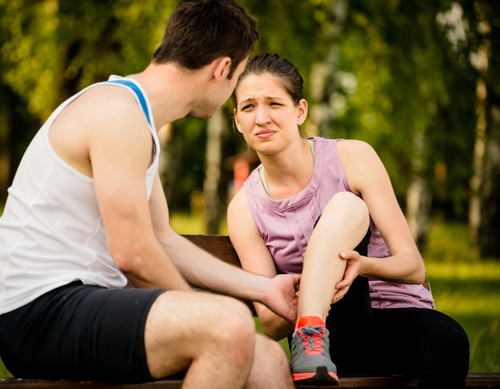 Exercise hurts—especially in the beginning—but how can you tell if the pain is due to an injury or to sore muscles?
Exercise hurts—especially in the beginning—but how can you tell if the pain is due to an injury or to sore muscles?
Is It an Injury or Muscle Pain?
When I was 15-years-old, I remember once sitting in a restaurant with my mom and brother, suffering from some of the worst pain of my life. It was my arms; they felt like they were on fire. In fact, I tried to jam a forkful of rice and beans into my mouth, only to have it drop down the front of my shirt, because my arms were like rubber.
The previous day in my physical education class, we’d hit the weights for the first time. I’d always been an active kid, but it was usually on the ice, court, or field. The weight room was completely foreign to me.
When you work out for the first time, you’re going to hurt afterwards, and it can really dissuade you from continuing. One of the most common questions I get is: how do I tell whether the pain after I work out is normal or if it’s an injury?
Differences Between an Injury and Sore Muscles
After exercise—whether you’re new to it or have been doing it for a long time—you’ll likely experience delayed-onset muscle soreness, or DOMS. DOMS is marked by tightness in the muscles, reduced range of motion, and a slight burning sensation. It’s completely normal and can be alleviated with proper rest, nutrition, and post-workout stretching.
An injury, on the other hand, can feel quite different. Joint pain or tingling around the joints is usually an indicator of an injury (either caused by exercise or something else).
How to Warm up Your Muscles to Prevent an Injury
In order to reduce the risk of a joint injury, warming up is essential. Before using weights or performing any sort of physical activity, target the primary movers. This will loosen up the joints and draw synovial fluid into them, which acts as a lubricant. Do not start your workout until you’re feeling loose and the joints are warm.
Likewise, you’ll also want to warm up your muscles to prevent strains, tears, or other muscle-related injuries. When the muscles are loose, you’re much less likely to experience an injury. Often, if you experience an injury during exercise, you’ll know it almost instantly—you will feel or hear it. In the slight chance you don’t, you’ll notice that the pain won’t be gone even after DOMS subsides.
For example, if you were doing biceps curls yesterday and you’ve noticed that one is still tight and extremely sore while the other has recovered—even after you performed the same protocol on both—you may have an injury. Ice it, and see how it feels the next day. If the pain continues, rest the muscle by avoiding use for strenuous exercise.
I don’t need to list the myriad of benefits of exercise here. But if your body is in pain after a workout and you’re wondering why, it’s probably just DOMS. As your muscles get used to it and become better trained, you’ll be glad you battled through!
